Strategic Management Report: Californian Nut Industry Analysis
VerifiedAdded on 2020/05/11
|11
|2958
|463
Report
AI Summary
This report provides a comprehensive analysis of strategic management within the Californian nut industry, focusing on the significant issue of theft across the supply chain. The report begins with an introduction to strategic management and its importance, followed by an overview of the theft situation, which includes sophisticated criminal activities targeting high-value nut shipments. A PESTEL analysis examines the political, economic, social, and technological factors influencing the industry. Furthermore, a Five Forces analysis evaluates industry rivalry, the threat of new entrants, substitutes, and the bargaining power of suppliers and buyers. The report identifies key resources and capabilities for combating theft, including law enforcement collaboration, awareness programs, and security measures. Finally, it highlights five organizations involved in theft prevention within the industry. The report concludes with recommendations for improving security and mitigating losses.

Running Header: Strategic Management
Strategic Management
Authors ID:
Authors Name:
Strategic Management
Authors ID:
Authors Name:
Paraphrase This Document
Need a fresh take? Get an instant paraphrase of this document with our AI Paraphraser
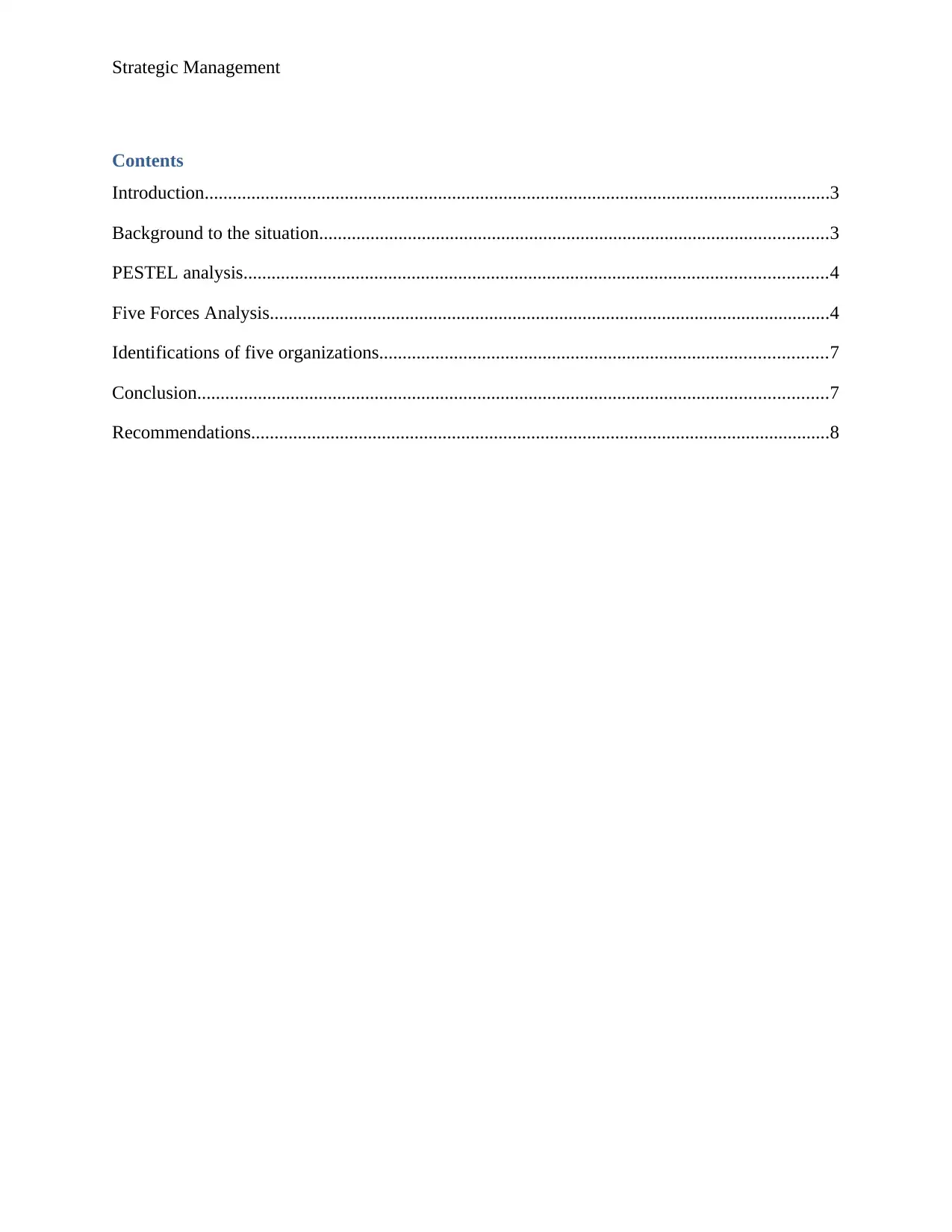
Strategic Management
Contents
Introduction......................................................................................................................................3
Background to the situation.............................................................................................................3
PESTEL analysis.............................................................................................................................4
Five Forces Analysis........................................................................................................................4
Identifications of five organizations................................................................................................7
Conclusion.......................................................................................................................................7
Recommendations............................................................................................................................8
Contents
Introduction......................................................................................................................................3
Background to the situation.............................................................................................................3
PESTEL analysis.............................................................................................................................4
Five Forces Analysis........................................................................................................................4
Identifications of five organizations................................................................................................7
Conclusion.......................................................................................................................................7
Recommendations............................................................................................................................8
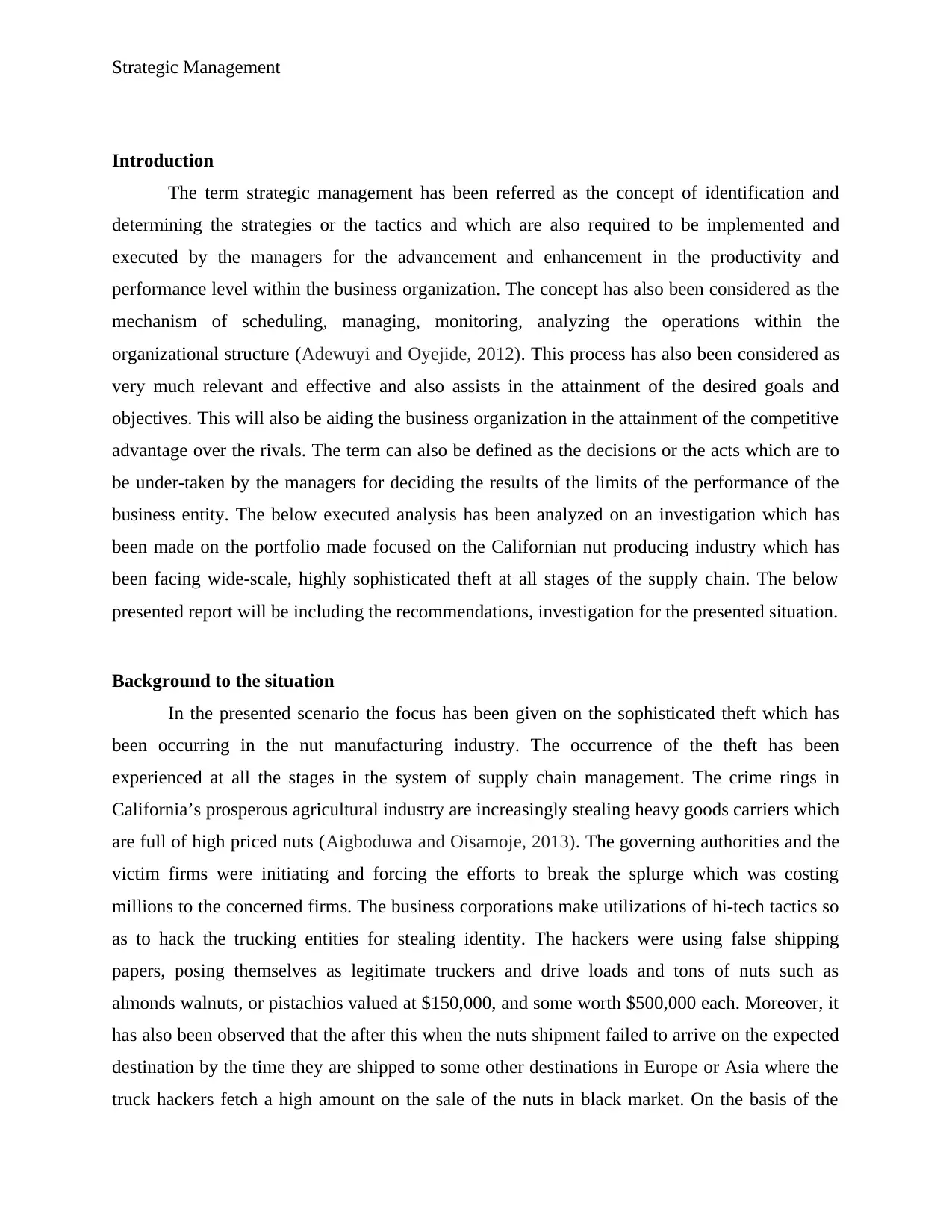
Strategic Management
Introduction
The term strategic management has been referred as the concept of identification and
determining the strategies or the tactics and which are also required to be implemented and
executed by the managers for the advancement and enhancement in the productivity and
performance level within the business organization. The concept has also been considered as the
mechanism of scheduling, managing, monitoring, analyzing the operations within the
organizational structure (Adewuyi and Oyejide, 2012). This process has also been considered as
very much relevant and effective and also assists in the attainment of the desired goals and
objectives. This will also be aiding the business organization in the attainment of the competitive
advantage over the rivals. The term can also be defined as the decisions or the acts which are to
be under-taken by the managers for deciding the results of the limits of the performance of the
business entity. The below executed analysis has been analyzed on an investigation which has
been made on the portfolio made focused on the Californian nut producing industry which has
been facing wide-scale, highly sophisticated theft at all stages of the supply chain. The below
presented report will be including the recommendations, investigation for the presented situation.
Background to the situation
In the presented scenario the focus has been given on the sophisticated theft which has
been occurring in the nut manufacturing industry. The occurrence of the theft has been
experienced at all the stages in the system of supply chain management. The crime rings in
California’s prosperous agricultural industry are increasingly stealing heavy goods carriers which
are full of high priced nuts (Aigboduwa and Oisamoje, 2013). The governing authorities and the
victim firms were initiating and forcing the efforts to break the splurge which was costing
millions to the concerned firms. The business corporations make utilizations of hi-tech tactics so
as to hack the trucking entities for stealing identity. The hackers were using false shipping
papers, posing themselves as legitimate truckers and drive loads and tons of nuts such as
almonds walnuts, or pistachios valued at $150,000, and some worth $500,000 each. Moreover, it
has also been observed that the after this when the nuts shipment failed to arrive on the expected
destination by the time they are shipped to some other destinations in Europe or Asia where the
truck hackers fetch a high amount on the sale of the nuts in black market. On the basis of the
Introduction
The term strategic management has been referred as the concept of identification and
determining the strategies or the tactics and which are also required to be implemented and
executed by the managers for the advancement and enhancement in the productivity and
performance level within the business organization. The concept has also been considered as the
mechanism of scheduling, managing, monitoring, analyzing the operations within the
organizational structure (Adewuyi and Oyejide, 2012). This process has also been considered as
very much relevant and effective and also assists in the attainment of the desired goals and
objectives. This will also be aiding the business organization in the attainment of the competitive
advantage over the rivals. The term can also be defined as the decisions or the acts which are to
be under-taken by the managers for deciding the results of the limits of the performance of the
business entity. The below executed analysis has been analyzed on an investigation which has
been made on the portfolio made focused on the Californian nut producing industry which has
been facing wide-scale, highly sophisticated theft at all stages of the supply chain. The below
presented report will be including the recommendations, investigation for the presented situation.
Background to the situation
In the presented scenario the focus has been given on the sophisticated theft which has
been occurring in the nut manufacturing industry. The occurrence of the theft has been
experienced at all the stages in the system of supply chain management. The crime rings in
California’s prosperous agricultural industry are increasingly stealing heavy goods carriers which
are full of high priced nuts (Aigboduwa and Oisamoje, 2013). The governing authorities and the
victim firms were initiating and forcing the efforts to break the splurge which was costing
millions to the concerned firms. The business corporations make utilizations of hi-tech tactics so
as to hack the trucking entities for stealing identity. The hackers were using false shipping
papers, posing themselves as legitimate truckers and drive loads and tons of nuts such as
almonds walnuts, or pistachios valued at $150,000, and some worth $500,000 each. Moreover, it
has also been observed that the after this when the nuts shipment failed to arrive on the expected
destination by the time they are shipped to some other destinations in Europe or Asia where the
truck hackers fetch a high amount on the sale of the nuts in black market. On the basis of the
⊘ This is a preview!⊘
Do you want full access?
Subscribe today to unlock all pages.

Trusted by 1+ million students worldwide
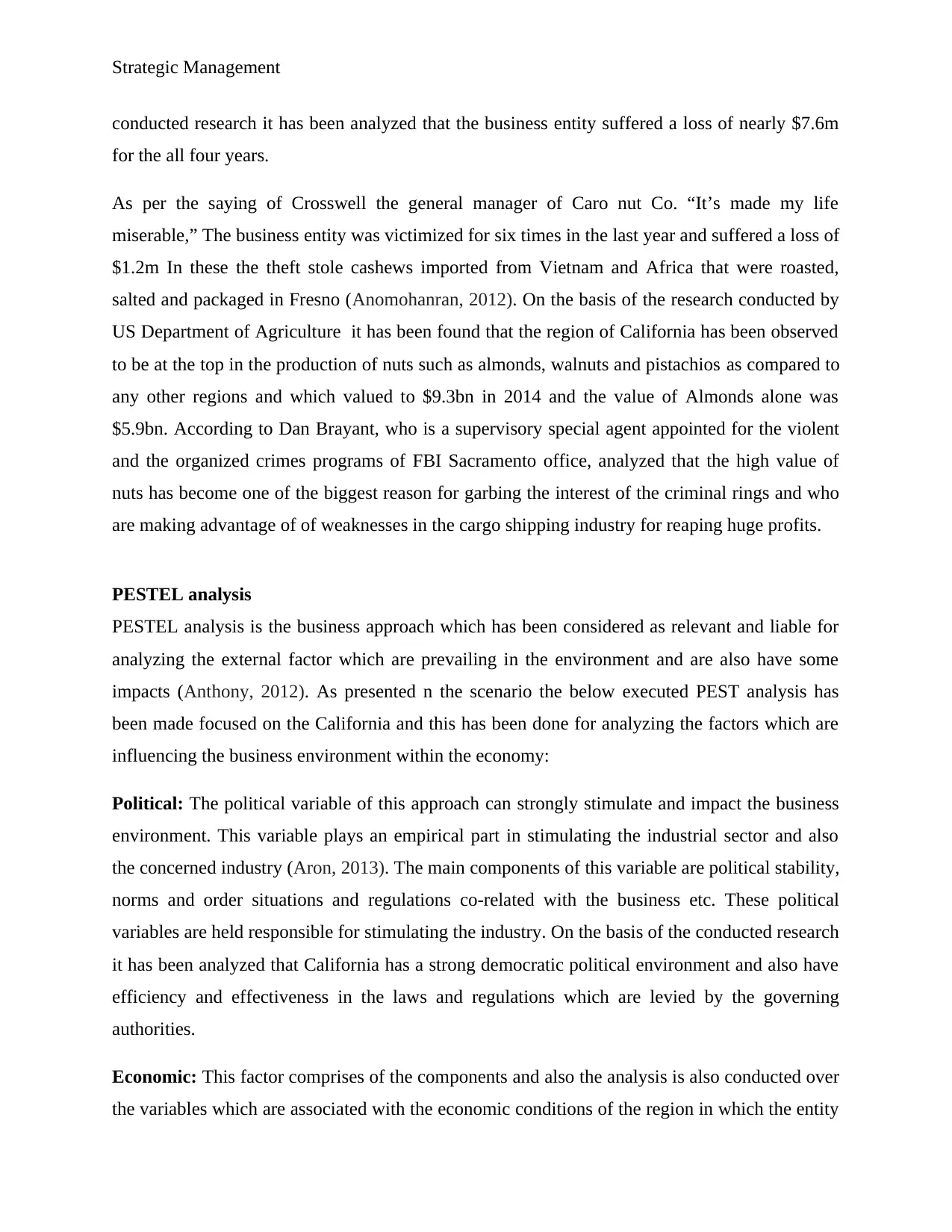
Strategic Management
conducted research it has been analyzed that the business entity suffered a loss of nearly $7.6m
for the all four years.
As per the saying of Crosswell the general manager of Caro nut Co. “It’s made my life
miserable,” The business entity was victimized for six times in the last year and suffered a loss of
$1.2m In these the theft stole cashews imported from Vietnam and Africa that were roasted,
salted and packaged in Fresno (Anomohanran, 2012). On the basis of the research conducted by
US Department of Agriculture it has been found that the region of California has been observed
to be at the top in the production of nuts such as almonds, walnuts and pistachios as compared to
any other regions and which valued to $9.3bn in 2014 and the value of Almonds alone was
$5.9bn. According to Dan Brayant, who is a supervisory special agent appointed for the violent
and the organized crimes programs of FBI Sacramento office, analyzed that the high value of
nuts has become one of the biggest reason for garbing the interest of the criminal rings and who
are making advantage of of weaknesses in the cargo shipping industry for reaping huge profits.
PESTEL analysis
PESTEL analysis is the business approach which has been considered as relevant and liable for
analyzing the external factor which are prevailing in the environment and are also have some
impacts (Anthony, 2012). As presented n the scenario the below executed PEST analysis has
been made focused on the California and this has been done for analyzing the factors which are
influencing the business environment within the economy:
Political: The political variable of this approach can strongly stimulate and impact the business
environment. This variable plays an empirical part in stimulating the industrial sector and also
the concerned industry (Aron, 2013). The main components of this variable are political stability,
norms and order situations and regulations co-related with the business etc. These political
variables are held responsible for stimulating the industry. On the basis of the conducted research
it has been analyzed that California has a strong democratic political environment and also have
efficiency and effectiveness in the laws and regulations which are levied by the governing
authorities.
Economic: This factor comprises of the components and also the analysis is also conducted over
the variables which are associated with the economic conditions of the region in which the entity
conducted research it has been analyzed that the business entity suffered a loss of nearly $7.6m
for the all four years.
As per the saying of Crosswell the general manager of Caro nut Co. “It’s made my life
miserable,” The business entity was victimized for six times in the last year and suffered a loss of
$1.2m In these the theft stole cashews imported from Vietnam and Africa that were roasted,
salted and packaged in Fresno (Anomohanran, 2012). On the basis of the research conducted by
US Department of Agriculture it has been found that the region of California has been observed
to be at the top in the production of nuts such as almonds, walnuts and pistachios as compared to
any other regions and which valued to $9.3bn in 2014 and the value of Almonds alone was
$5.9bn. According to Dan Brayant, who is a supervisory special agent appointed for the violent
and the organized crimes programs of FBI Sacramento office, analyzed that the high value of
nuts has become one of the biggest reason for garbing the interest of the criminal rings and who
are making advantage of of weaknesses in the cargo shipping industry for reaping huge profits.
PESTEL analysis
PESTEL analysis is the business approach which has been considered as relevant and liable for
analyzing the external factor which are prevailing in the environment and are also have some
impacts (Anthony, 2012). As presented n the scenario the below executed PEST analysis has
been made focused on the California and this has been done for analyzing the factors which are
influencing the business environment within the economy:
Political: The political variable of this approach can strongly stimulate and impact the business
environment. This variable plays an empirical part in stimulating the industrial sector and also
the concerned industry (Aron, 2013). The main components of this variable are political stability,
norms and order situations and regulations co-related with the business etc. These political
variables are held responsible for stimulating the industry. On the basis of the conducted research
it has been analyzed that California has a strong democratic political environment and also have
efficiency and effectiveness in the laws and regulations which are levied by the governing
authorities.
Economic: This factor comprises of the components and also the analysis is also conducted over
the variables which are associated with the economic conditions of the region in which the entity
Paraphrase This Document
Need a fresh take? Get an instant paraphrase of this document with our AI Paraphraser
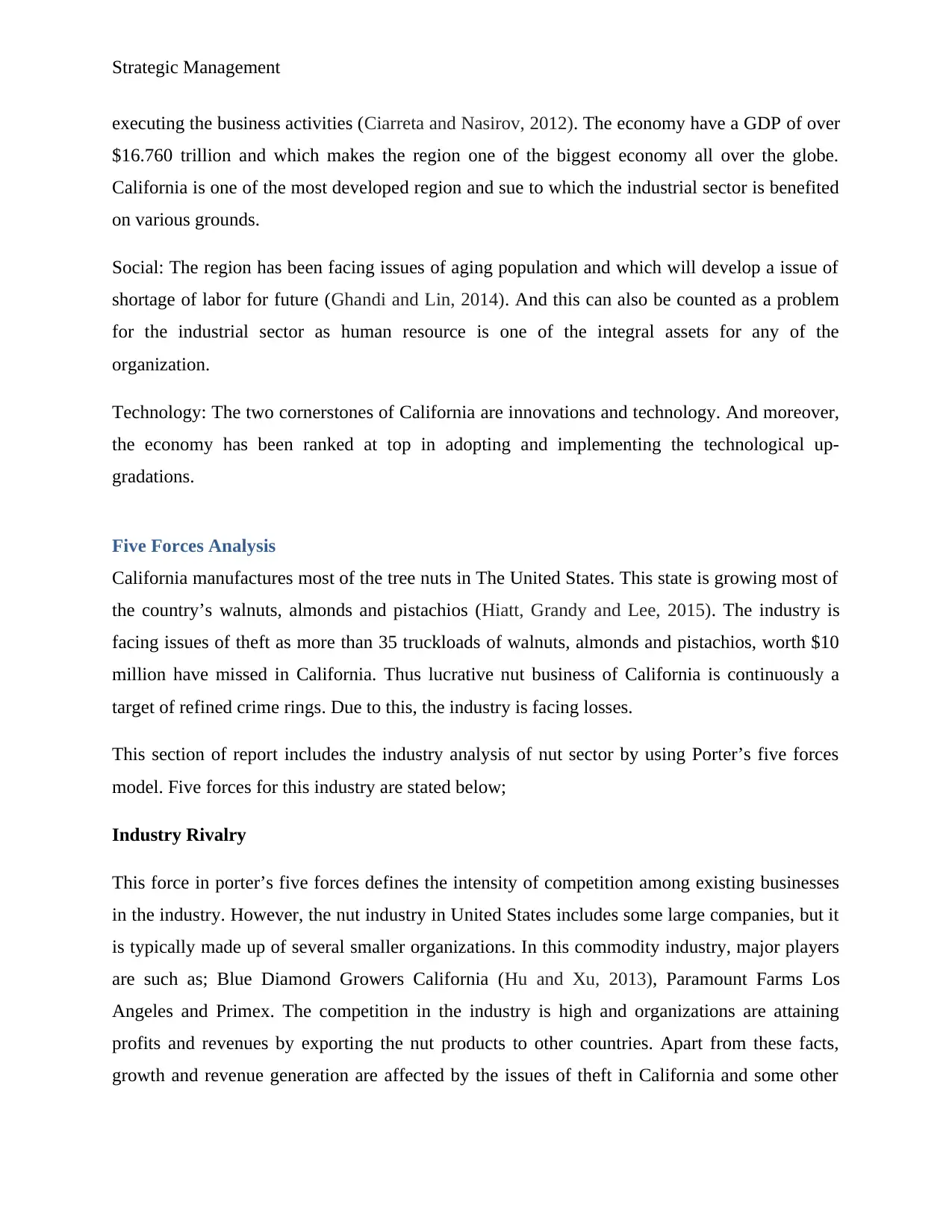
Strategic Management
executing the business activities (Ciarreta and Nasirov, 2012). The economy have a GDP of over
$16.760 trillion and which makes the region one of the biggest economy all over the globe.
California is one of the most developed region and sue to which the industrial sector is benefited
on various grounds.
Social: The region has been facing issues of aging population and which will develop a issue of
shortage of labor for future (Ghandi and Lin, 2014). And this can also be counted as a problem
for the industrial sector as human resource is one of the integral assets for any of the
organization.
Technology: The two cornerstones of California are innovations and technology. And moreover,
the economy has been ranked at top in adopting and implementing the technological up-
gradations.
Five Forces Analysis
California manufactures most of the tree nuts in The United States. This state is growing most of
the country’s walnuts, almonds and pistachios (Hiatt, Grandy and Lee, 2015). The industry is
facing issues of theft as more than 35 truckloads of walnuts, almonds and pistachios, worth $10
million have missed in California. Thus lucrative nut business of California is continuously a
target of refined crime rings. Due to this, the industry is facing losses.
This section of report includes the industry analysis of nut sector by using Porter’s five forces
model. Five forces for this industry are stated below;
Industry Rivalry
This force in porter’s five forces defines the intensity of competition among existing businesses
in the industry. However, the nut industry in United States includes some large companies, but it
is typically made up of several smaller organizations. In this commodity industry, major players
are such as; Blue Diamond Growers California (Hu and Xu, 2013), Paramount Farms Los
Angeles and Primex. The competition in the industry is high and organizations are attaining
profits and revenues by exporting the nut products to other countries. Apart from these facts,
growth and revenue generation are affected by the issues of theft in California and some other
executing the business activities (Ciarreta and Nasirov, 2012). The economy have a GDP of over
$16.760 trillion and which makes the region one of the biggest economy all over the globe.
California is one of the most developed region and sue to which the industrial sector is benefited
on various grounds.
Social: The region has been facing issues of aging population and which will develop a issue of
shortage of labor for future (Ghandi and Lin, 2014). And this can also be counted as a problem
for the industrial sector as human resource is one of the integral assets for any of the
organization.
Technology: The two cornerstones of California are innovations and technology. And moreover,
the economy has been ranked at top in adopting and implementing the technological up-
gradations.
Five Forces Analysis
California manufactures most of the tree nuts in The United States. This state is growing most of
the country’s walnuts, almonds and pistachios (Hiatt, Grandy and Lee, 2015). The industry is
facing issues of theft as more than 35 truckloads of walnuts, almonds and pistachios, worth $10
million have missed in California. Thus lucrative nut business of California is continuously a
target of refined crime rings. Due to this, the industry is facing losses.
This section of report includes the industry analysis of nut sector by using Porter’s five forces
model. Five forces for this industry are stated below;
Industry Rivalry
This force in porter’s five forces defines the intensity of competition among existing businesses
in the industry. However, the nut industry in United States includes some large companies, but it
is typically made up of several smaller organizations. In this commodity industry, major players
are such as; Blue Diamond Growers California (Hu and Xu, 2013), Paramount Farms Los
Angeles and Primex. The competition in the industry is high and organizations are attaining
profits and revenues by exporting the nut products to other countries. Apart from these facts,
growth and revenue generation are affected by the issues of theft in California and some other
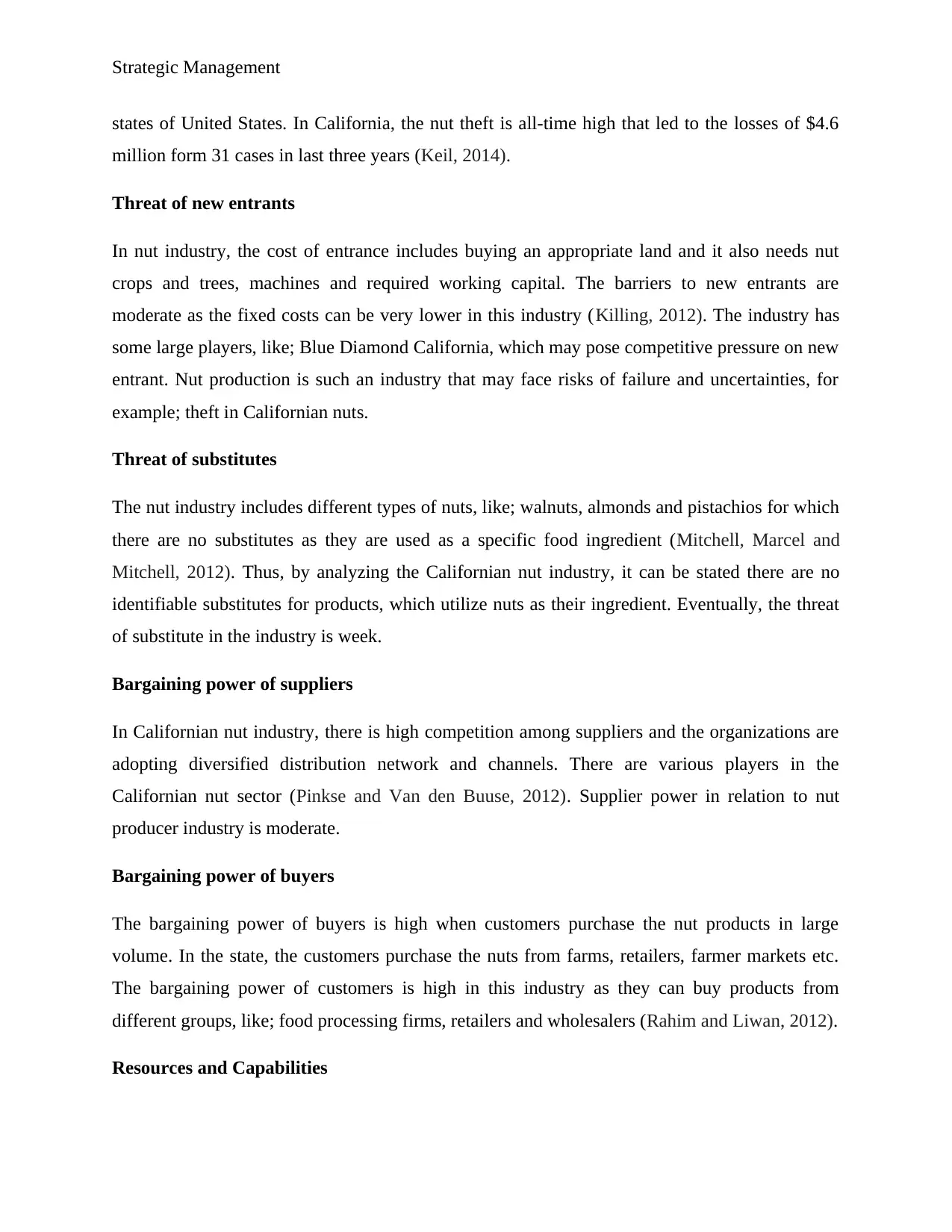
Strategic Management
states of United States. In California, the nut theft is all-time high that led to the losses of $4.6
million form 31 cases in last three years (Keil, 2014).
Threat of new entrants
In nut industry, the cost of entrance includes buying an appropriate land and it also needs nut
crops and trees, machines and required working capital. The barriers to new entrants are
moderate as the fixed costs can be very lower in this industry (Killing, 2012). The industry has
some large players, like; Blue Diamond California, which may pose competitive pressure on new
entrant. Nut production is such an industry that may face risks of failure and uncertainties, for
example; theft in Californian nuts.
Threat of substitutes
The nut industry includes different types of nuts, like; walnuts, almonds and pistachios for which
there are no substitutes as they are used as a specific food ingredient (Mitchell, Marcel and
Mitchell, 2012). Thus, by analyzing the Californian nut industry, it can be stated there are no
identifiable substitutes for products, which utilize nuts as their ingredient. Eventually, the threat
of substitute in the industry is week.
Bargaining power of suppliers
In Californian nut industry, there is high competition among suppliers and the organizations are
adopting diversified distribution network and channels. There are various players in the
Californian nut sector (Pinkse and Van den Buuse, 2012). Supplier power in relation to nut
producer industry is moderate.
Bargaining power of buyers
The bargaining power of buyers is high when customers purchase the nut products in large
volume. In the state, the customers purchase the nuts from farms, retailers, farmer markets etc.
The bargaining power of customers is high in this industry as they can buy products from
different groups, like; food processing firms, retailers and wholesalers (Rahim and Liwan, 2012).
Resources and Capabilities
states of United States. In California, the nut theft is all-time high that led to the losses of $4.6
million form 31 cases in last three years (Keil, 2014).
Threat of new entrants
In nut industry, the cost of entrance includes buying an appropriate land and it also needs nut
crops and trees, machines and required working capital. The barriers to new entrants are
moderate as the fixed costs can be very lower in this industry (Killing, 2012). The industry has
some large players, like; Blue Diamond California, which may pose competitive pressure on new
entrant. Nut production is such an industry that may face risks of failure and uncertainties, for
example; theft in Californian nuts.
Threat of substitutes
The nut industry includes different types of nuts, like; walnuts, almonds and pistachios for which
there are no substitutes as they are used as a specific food ingredient (Mitchell, Marcel and
Mitchell, 2012). Thus, by analyzing the Californian nut industry, it can be stated there are no
identifiable substitutes for products, which utilize nuts as their ingredient. Eventually, the threat
of substitute in the industry is week.
Bargaining power of suppliers
In Californian nut industry, there is high competition among suppliers and the organizations are
adopting diversified distribution network and channels. There are various players in the
Californian nut sector (Pinkse and Van den Buuse, 2012). Supplier power in relation to nut
producer industry is moderate.
Bargaining power of buyers
The bargaining power of buyers is high when customers purchase the nut products in large
volume. In the state, the customers purchase the nuts from farms, retailers, farmer markets etc.
The bargaining power of customers is high in this industry as they can buy products from
different groups, like; food processing firms, retailers and wholesalers (Rahim and Liwan, 2012).
Resources and Capabilities
⊘ This is a preview!⊘
Do you want full access?
Subscribe today to unlock all pages.

Trusted by 1+ million students worldwide
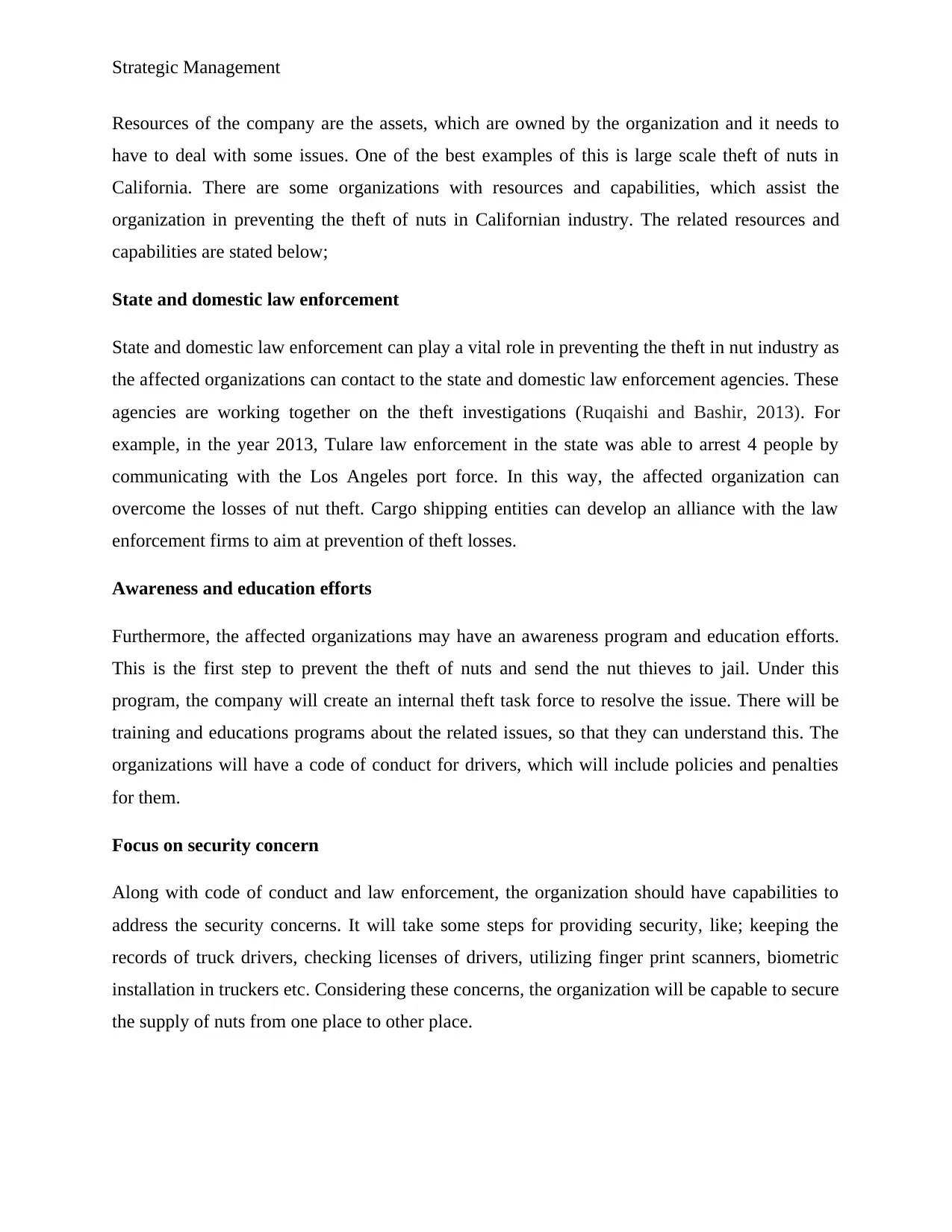
Strategic Management
Resources of the company are the assets, which are owned by the organization and it needs to
have to deal with some issues. One of the best examples of this is large scale theft of nuts in
California. There are some organizations with resources and capabilities, which assist the
organization in preventing the theft of nuts in Californian industry. The related resources and
capabilities are stated below;
State and domestic law enforcement
State and domestic law enforcement can play a vital role in preventing the theft in nut industry as
the affected organizations can contact to the state and domestic law enforcement agencies. These
agencies are working together on the theft investigations (Ruqaishi and Bashir, 2013). For
example, in the year 2013, Tulare law enforcement in the state was able to arrest 4 people by
communicating with the Los Angeles port force. In this way, the affected organization can
overcome the losses of nut theft. Cargo shipping entities can develop an alliance with the law
enforcement firms to aim at prevention of theft losses.
Awareness and education efforts
Furthermore, the affected organizations may have an awareness program and education efforts.
This is the first step to prevent the theft of nuts and send the nut thieves to jail. Under this
program, the company will create an internal theft task force to resolve the issue. There will be
training and educations programs about the related issues, so that they can understand this. The
organizations will have a code of conduct for drivers, which will include policies and penalties
for them.
Focus on security concern
Along with code of conduct and law enforcement, the organization should have capabilities to
address the security concerns. It will take some steps for providing security, like; keeping the
records of truck drivers, checking licenses of drivers, utilizing finger print scanners, biometric
installation in truckers etc. Considering these concerns, the organization will be capable to secure
the supply of nuts from one place to other place.
Resources of the company are the assets, which are owned by the organization and it needs to
have to deal with some issues. One of the best examples of this is large scale theft of nuts in
California. There are some organizations with resources and capabilities, which assist the
organization in preventing the theft of nuts in Californian industry. The related resources and
capabilities are stated below;
State and domestic law enforcement
State and domestic law enforcement can play a vital role in preventing the theft in nut industry as
the affected organizations can contact to the state and domestic law enforcement agencies. These
agencies are working together on the theft investigations (Ruqaishi and Bashir, 2013). For
example, in the year 2013, Tulare law enforcement in the state was able to arrest 4 people by
communicating with the Los Angeles port force. In this way, the affected organization can
overcome the losses of nut theft. Cargo shipping entities can develop an alliance with the law
enforcement firms to aim at prevention of theft losses.
Awareness and education efforts
Furthermore, the affected organizations may have an awareness program and education efforts.
This is the first step to prevent the theft of nuts and send the nut thieves to jail. Under this
program, the company will create an internal theft task force to resolve the issue. There will be
training and educations programs about the related issues, so that they can understand this. The
organizations will have a code of conduct for drivers, which will include policies and penalties
for them.
Focus on security concern
Along with code of conduct and law enforcement, the organization should have capabilities to
address the security concerns. It will take some steps for providing security, like; keeping the
records of truck drivers, checking licenses of drivers, utilizing finger print scanners, biometric
installation in truckers etc. Considering these concerns, the organization will be capable to secure
the supply of nuts from one place to other place.
Paraphrase This Document
Need a fresh take? Get an instant paraphrase of this document with our AI Paraphraser
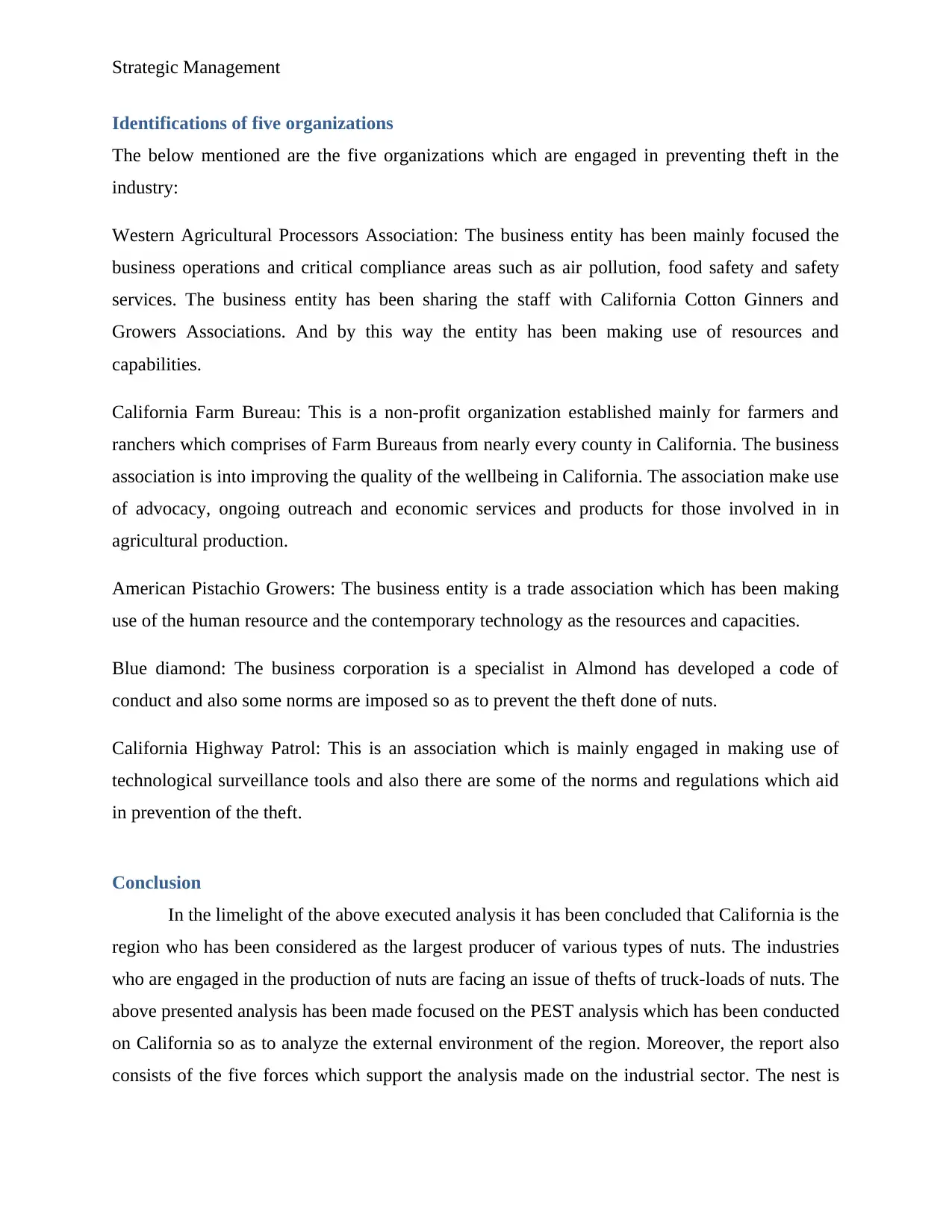
Strategic Management
Identifications of five organizations
The below mentioned are the five organizations which are engaged in preventing theft in the
industry:
Western Agricultural Processors Association: The business entity has been mainly focused the
business operations and critical compliance areas such as air pollution, food safety and safety
services. The business entity has been sharing the staff with California Cotton Ginners and
Growers Associations. And by this way the entity has been making use of resources and
capabilities.
California Farm Bureau: This is a non-profit organization established mainly for farmers and
ranchers which comprises of Farm Bureaus from nearly every county in California. The business
association is into improving the quality of the wellbeing in California. The association make use
of advocacy, ongoing outreach and economic services and products for those involved in in
agricultural production.
American Pistachio Growers: The business entity is a trade association which has been making
use of the human resource and the contemporary technology as the resources and capacities.
Blue diamond: The business corporation is a specialist in Almond has developed a code of
conduct and also some norms are imposed so as to prevent the theft done of nuts.
California Highway Patrol: This is an association which is mainly engaged in making use of
technological surveillance tools and also there are some of the norms and regulations which aid
in prevention of the theft.
Conclusion
In the limelight of the above executed analysis it has been concluded that California is the
region who has been considered as the largest producer of various types of nuts. The industries
who are engaged in the production of nuts are facing an issue of thefts of truck-loads of nuts. The
above presented analysis has been made focused on the PEST analysis which has been conducted
on California so as to analyze the external environment of the region. Moreover, the report also
consists of the five forces which support the analysis made on the industrial sector. The nest is
Identifications of five organizations
The below mentioned are the five organizations which are engaged in preventing theft in the
industry:
Western Agricultural Processors Association: The business entity has been mainly focused the
business operations and critical compliance areas such as air pollution, food safety and safety
services. The business entity has been sharing the staff with California Cotton Ginners and
Growers Associations. And by this way the entity has been making use of resources and
capabilities.
California Farm Bureau: This is a non-profit organization established mainly for farmers and
ranchers which comprises of Farm Bureaus from nearly every county in California. The business
association is into improving the quality of the wellbeing in California. The association make use
of advocacy, ongoing outreach and economic services and products for those involved in in
agricultural production.
American Pistachio Growers: The business entity is a trade association which has been making
use of the human resource and the contemporary technology as the resources and capacities.
Blue diamond: The business corporation is a specialist in Almond has developed a code of
conduct and also some norms are imposed so as to prevent the theft done of nuts.
California Highway Patrol: This is an association which is mainly engaged in making use of
technological surveillance tools and also there are some of the norms and regulations which aid
in prevention of the theft.
Conclusion
In the limelight of the above executed analysis it has been concluded that California is the
region who has been considered as the largest producer of various types of nuts. The industries
who are engaged in the production of nuts are facing an issue of thefts of truck-loads of nuts. The
above presented analysis has been made focused on the PEST analysis which has been conducted
on California so as to analyze the external environment of the region. Moreover, the report also
consists of the five forces which support the analysis made on the industrial sector. The nest is
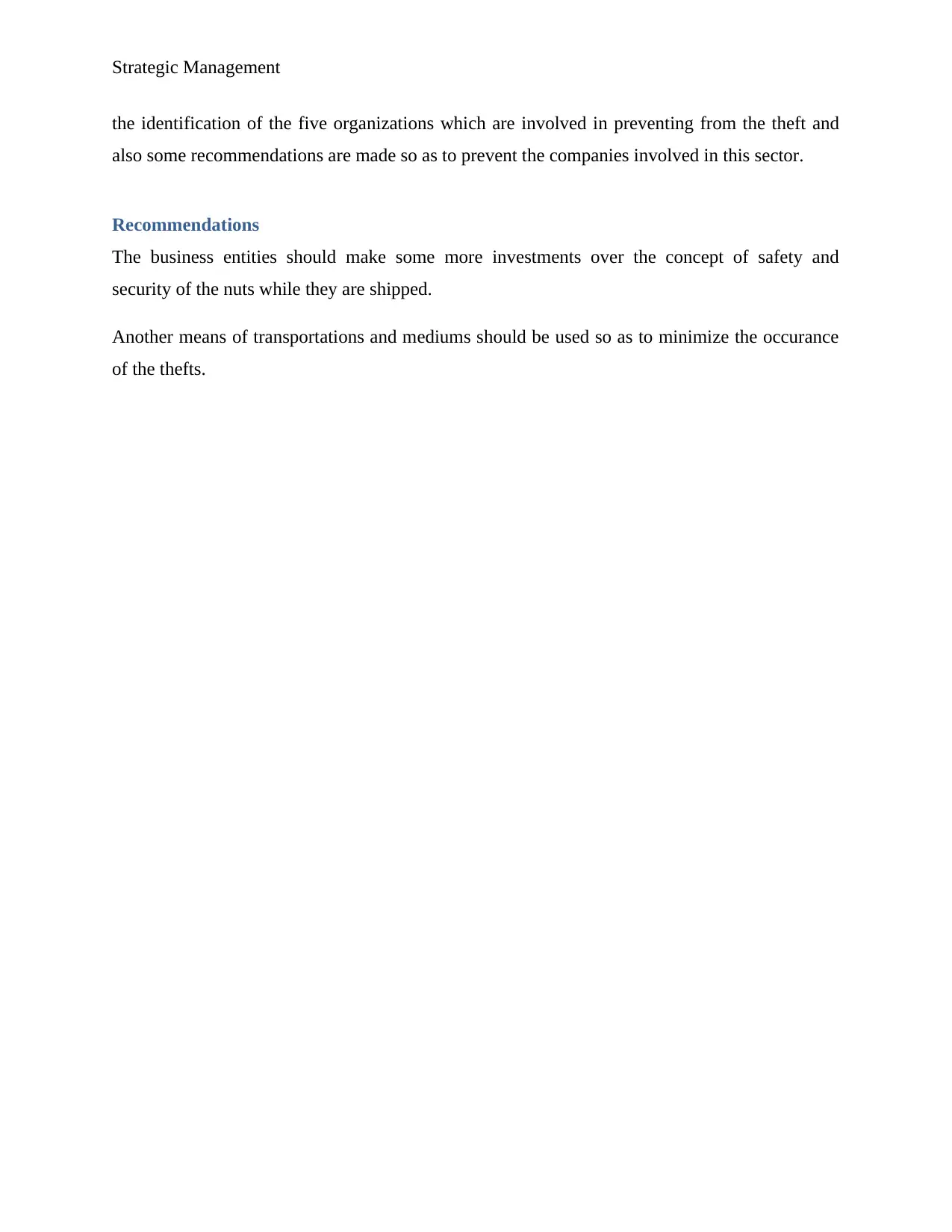
Strategic Management
the identification of the five organizations which are involved in preventing from the theft and
also some recommendations are made so as to prevent the companies involved in this sector.
Recommendations
The business entities should make some more investments over the concept of safety and
security of the nuts while they are shipped.
Another means of transportations and mediums should be used so as to minimize the occurance
of the thefts.
the identification of the five organizations which are involved in preventing from the theft and
also some recommendations are made so as to prevent the companies involved in this sector.
Recommendations
The business entities should make some more investments over the concept of safety and
security of the nuts while they are shipped.
Another means of transportations and mediums should be used so as to minimize the occurance
of the thefts.
⊘ This is a preview!⊘
Do you want full access?
Subscribe today to unlock all pages.

Trusted by 1+ million students worldwide
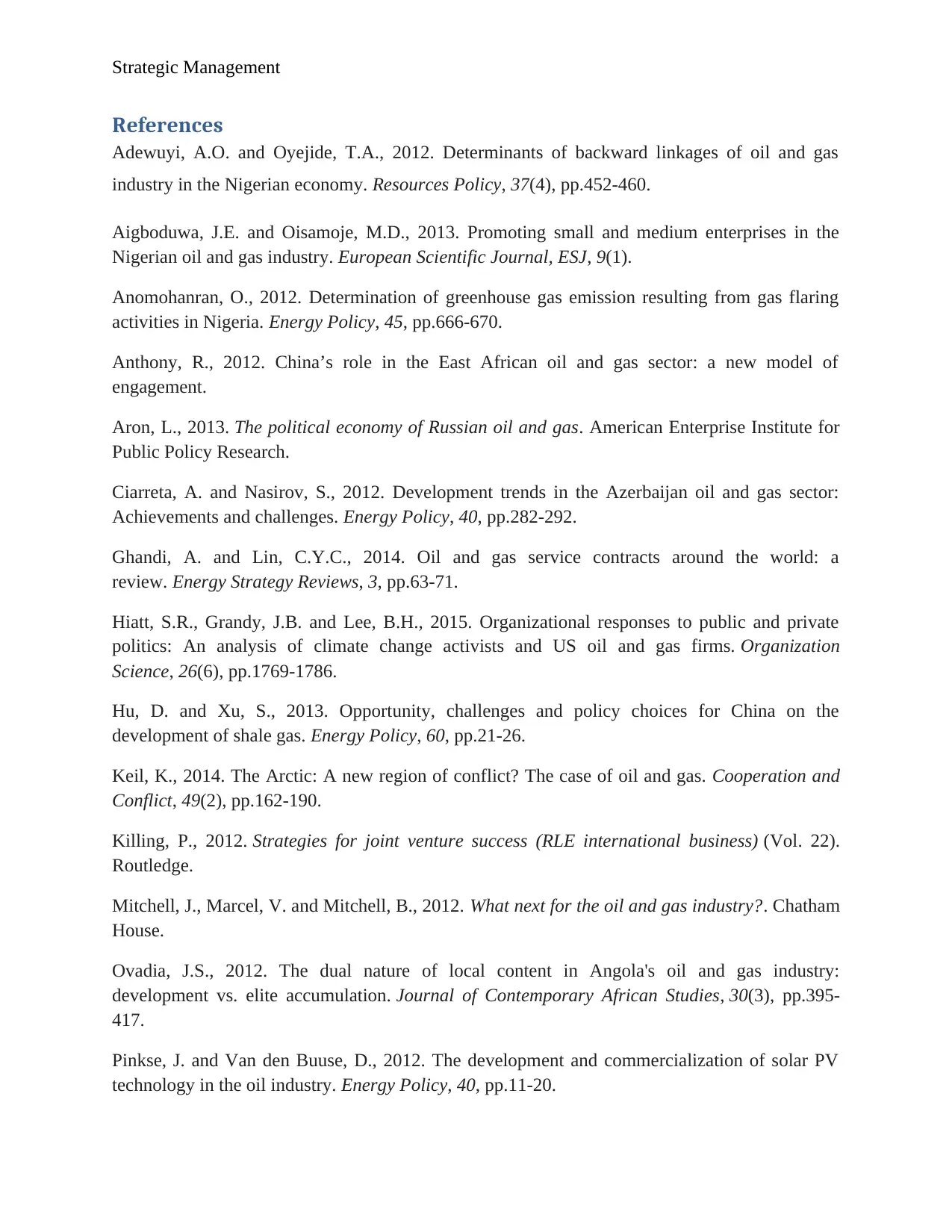
Strategic Management
References
Adewuyi, A.O. and Oyejide, T.A., 2012. Determinants of backward linkages of oil and gas
industry in the Nigerian economy. Resources Policy, 37(4), pp.452-460.
Aigboduwa, J.E. and Oisamoje, M.D., 2013. Promoting small and medium enterprises in the
Nigerian oil and gas industry. European Scientific Journal, ESJ, 9(1).
Anomohanran, O., 2012. Determination of greenhouse gas emission resulting from gas flaring
activities in Nigeria. Energy Policy, 45, pp.666-670.
Anthony, R., 2012. China’s role in the East African oil and gas sector: a new model of
engagement.
Aron, L., 2013. The political economy of Russian oil and gas. American Enterprise Institute for
Public Policy Research.
Ciarreta, A. and Nasirov, S., 2012. Development trends in the Azerbaijan oil and gas sector:
Achievements and challenges. Energy Policy, 40, pp.282-292.
Ghandi, A. and Lin, C.Y.C., 2014. Oil and gas service contracts around the world: a
review. Energy Strategy Reviews, 3, pp.63-71.
Hiatt, S.R., Grandy, J.B. and Lee, B.H., 2015. Organizational responses to public and private
politics: An analysis of climate change activists and US oil and gas firms. Organization
Science, 26(6), pp.1769-1786.
Hu, D. and Xu, S., 2013. Opportunity, challenges and policy choices for China on the
development of shale gas. Energy Policy, 60, pp.21-26.
Keil, K., 2014. The Arctic: A new region of conflict? The case of oil and gas. Cooperation and
Conflict, 49(2), pp.162-190.
Killing, P., 2012. Strategies for joint venture success (RLE international business) (Vol. 22).
Routledge.
Mitchell, J., Marcel, V. and Mitchell, B., 2012. What next for the oil and gas industry?. Chatham
House.
Ovadia, J.S., 2012. The dual nature of local content in Angola's oil and gas industry:
development vs. elite accumulation. Journal of Contemporary African Studies, 30(3), pp.395-
417.
Pinkse, J. and Van den Buuse, D., 2012. The development and commercialization of solar PV
technology in the oil industry. Energy Policy, 40, pp.11-20.
References
Adewuyi, A.O. and Oyejide, T.A., 2012. Determinants of backward linkages of oil and gas
industry in the Nigerian economy. Resources Policy, 37(4), pp.452-460.
Aigboduwa, J.E. and Oisamoje, M.D., 2013. Promoting small and medium enterprises in the
Nigerian oil and gas industry. European Scientific Journal, ESJ, 9(1).
Anomohanran, O., 2012. Determination of greenhouse gas emission resulting from gas flaring
activities in Nigeria. Energy Policy, 45, pp.666-670.
Anthony, R., 2012. China’s role in the East African oil and gas sector: a new model of
engagement.
Aron, L., 2013. The political economy of Russian oil and gas. American Enterprise Institute for
Public Policy Research.
Ciarreta, A. and Nasirov, S., 2012. Development trends in the Azerbaijan oil and gas sector:
Achievements and challenges. Energy Policy, 40, pp.282-292.
Ghandi, A. and Lin, C.Y.C., 2014. Oil and gas service contracts around the world: a
review. Energy Strategy Reviews, 3, pp.63-71.
Hiatt, S.R., Grandy, J.B. and Lee, B.H., 2015. Organizational responses to public and private
politics: An analysis of climate change activists and US oil and gas firms. Organization
Science, 26(6), pp.1769-1786.
Hu, D. and Xu, S., 2013. Opportunity, challenges and policy choices for China on the
development of shale gas. Energy Policy, 60, pp.21-26.
Keil, K., 2014. The Arctic: A new region of conflict? The case of oil and gas. Cooperation and
Conflict, 49(2), pp.162-190.
Killing, P., 2012. Strategies for joint venture success (RLE international business) (Vol. 22).
Routledge.
Mitchell, J., Marcel, V. and Mitchell, B., 2012. What next for the oil and gas industry?. Chatham
House.
Ovadia, J.S., 2012. The dual nature of local content in Angola's oil and gas industry:
development vs. elite accumulation. Journal of Contemporary African Studies, 30(3), pp.395-
417.
Pinkse, J. and Van den Buuse, D., 2012. The development and commercialization of solar PV
technology in the oil industry. Energy Policy, 40, pp.11-20.
Paraphrase This Document
Need a fresh take? Get an instant paraphrase of this document with our AI Paraphraser

Strategic Management
Rahim, K.A. and Liwan, A., 2012. Oil and gas trends and implications in Malaysia. Energy
Policy, 50, pp.262-271.
Ruqaishi, M. and Bashir, H.A., 2013. Causes of delay in construction projects in the oil and gas
industry in the gulf cooperation council countries: a case study. Journal of Management in
Engineering, 31(3), p.05014017.
Rahim, K.A. and Liwan, A., 2012. Oil and gas trends and implications in Malaysia. Energy
Policy, 50, pp.262-271.
Ruqaishi, M. and Bashir, H.A., 2013. Causes of delay in construction projects in the oil and gas
industry in the gulf cooperation council countries: a case study. Journal of Management in
Engineering, 31(3), p.05014017.
1 out of 11
Related Documents
Your All-in-One AI-Powered Toolkit for Academic Success.
+13062052269
info@desklib.com
Available 24*7 on WhatsApp / Email
![[object Object]](/_next/static/media/star-bottom.7253800d.svg)
Unlock your academic potential
Copyright © 2020–2025 A2Z Services. All Rights Reserved. Developed and managed by ZUCOL.





